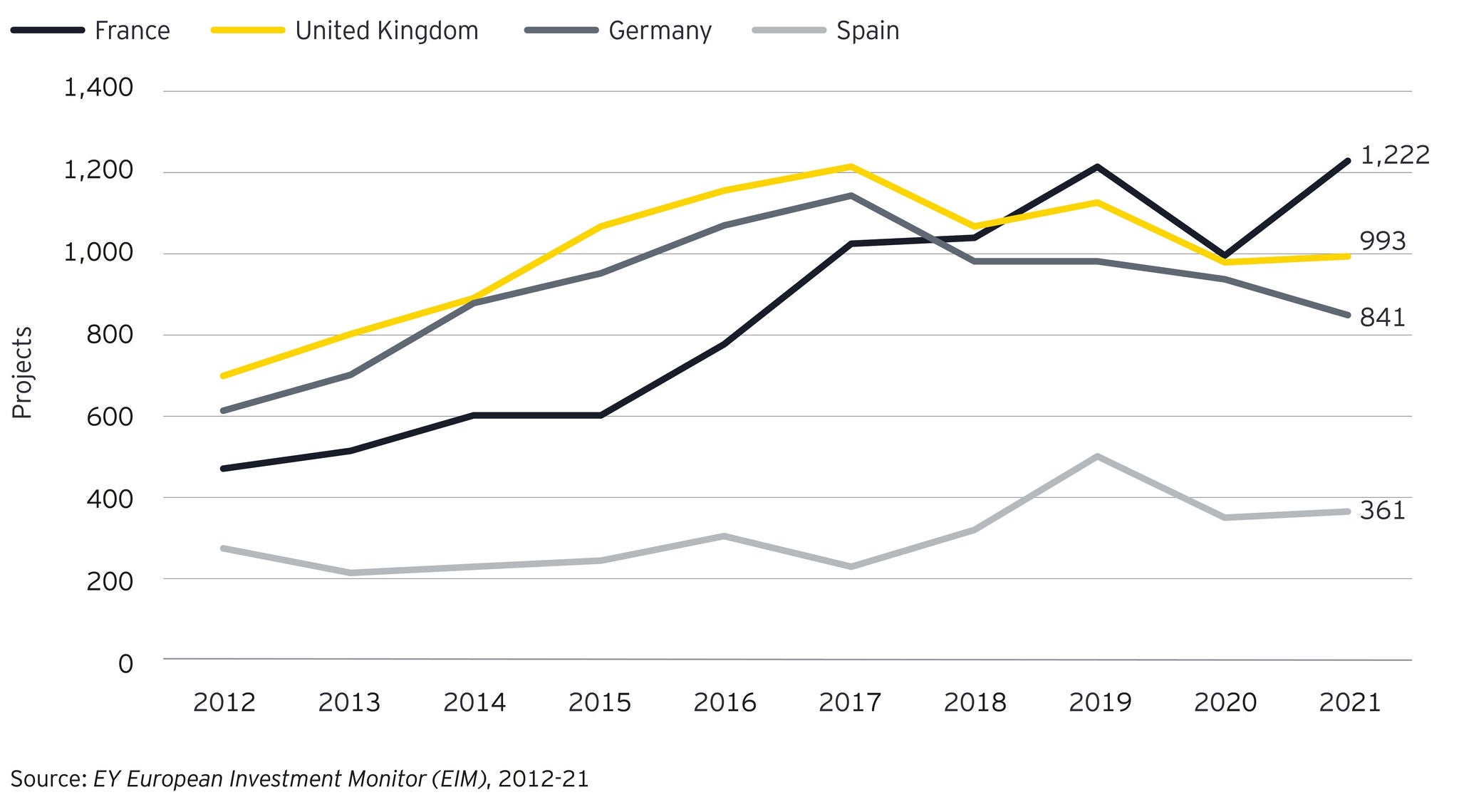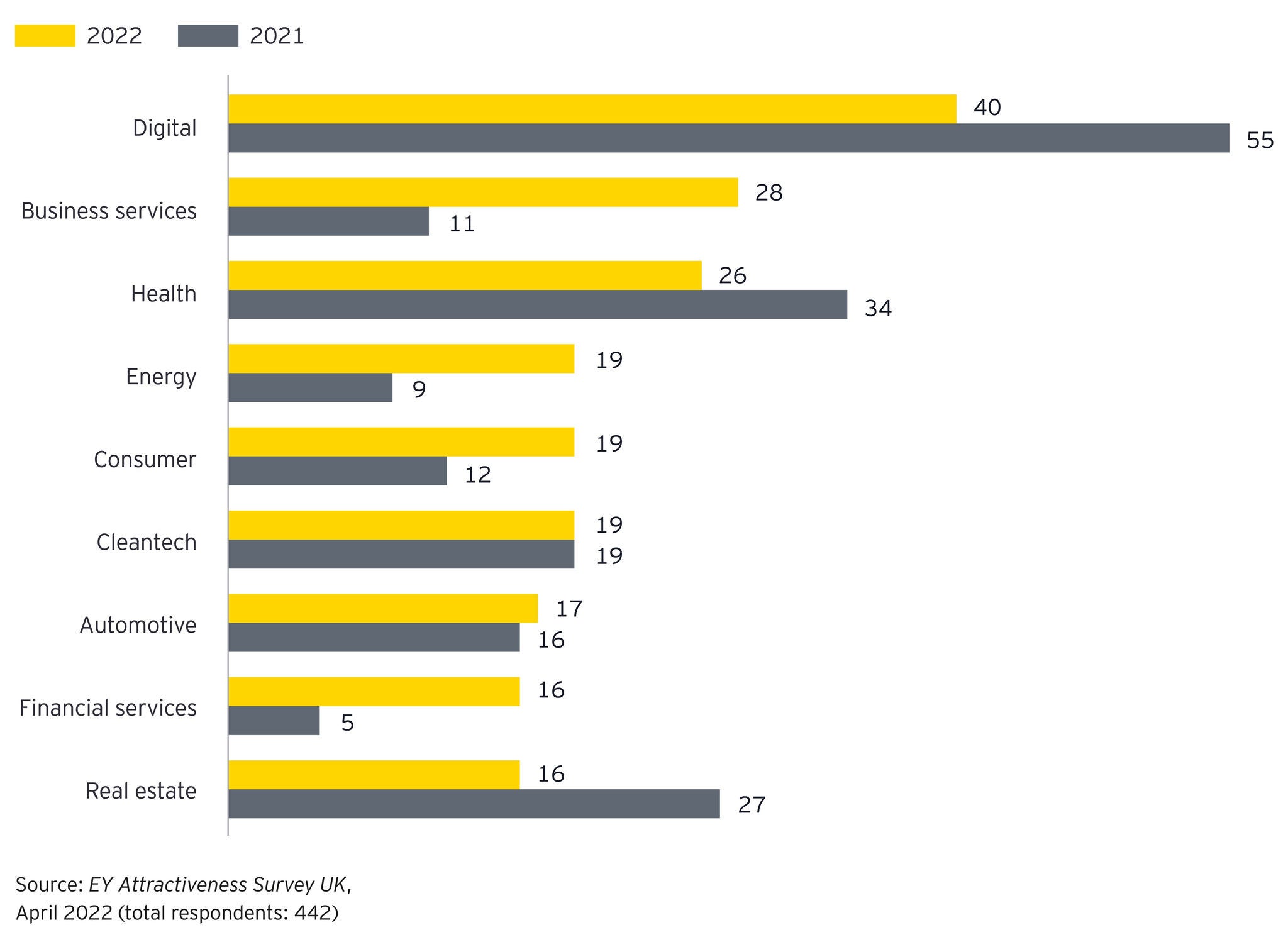EY refers to the global organization, and may refer to one or more, of the member firms of Ernst & Young Global Limited, each of which is a separate legal entity. Ernst & Young Global Limited, a UK company limited by guarantee, does not provide services to clients.
How EY can help
-
Our Strategy Consulting teams help CEOs achieve maximum value for stakeholders by designing strategies that improve profitability and long-term value.
Read more
The European market is changing in terms of sectors
Investments in digital technology and business services — Europe’s two largest sectors over the decade and core UK strengths — were down by over a fifth across Europe in 2021 compared with 2019. By contrast, manufacturing projects in 2021 (2,704) were above the annual average between 2014 and 2018, and 33% higher than in 2020.
This suggests the long-expected realignment of supply chains is underway. With Europe’s utility projects up by over 50% in the past two years, and health and well-being growing by almost a fifth , the impact of changing policy priorities is clear. The UK claimed a market-leading share in both sectors.
The international geography of UK FDI origins is shifting
Whilst the US remained the largest source of UK projects in 2021, its share was just 24% — way off its 2012-high of 39%. Meanwhile, India overtook Germany and France into second place amongst UK origins with 64 projects — up from 50 in 2020. Turkey emerged in sixth place with 38 projects.
Domestically, London remains subdued — whilst Scotland and Bristol perform strongly
2020 saw a major shift in the UK’s regional FDI landscape, with London’s share of incoming projects down by almost 10 points to 39.3%. In 2021, this market share was almost unchanged — at 39.7%. However, London remained Europe’s leading FDI city: its 394 projects in 2021 was way ahead of Madrid’s 140 and Paris’ 133.
Outside of London, Scotland had another strong year, securing 122 projects (14% rise) — meaning it garnered 12.3% of the UK total. Elsewhere, FDI in most regions and devolved administrations reverted towards 2019 levels. The main gainers were the South West — 30% up on 2019 driven by Bristol — and the West Midlands and Northern Ireland — both up around one-fifth.
The UK’s FDI outlook is positive, both short- and medium-term
Encouragingly, our investor survey reveals very positive sentiment towards UK investment. Some 58% of the investors are planning to invest in the UK in 2022 — up from 41% last year and the highest level ever recorded. 49% think the UK will be more attractive in three years’ time — slightly down from last year’s 52% — but still very strong historically.
Investors are voicing new concerns over investments
However, investment intentions should be treated cautiously, as new concerns are emerging. In our European survey, 81% of the investors surveyed before 1 March 2022 were planning to invest during the next 12 months. That proportion fell to just 25% of those surveyed after 15 March 2022, reflecting the war in Ukraine.
The priorities of investors have shifted, creating FDI growth opportunities in several sectors
As the pandemic eases, health and well-being has slipped from investors’ most important theme in 2021 to seventh in 2022. Whilst sustainability has gained one place to take top spot, the biggest movers are deglobalisation (up to second from eighth two years ago) and the changing economic model of city centres (up to third from fifth). Investors are also increasingly aware of the role of governments.
Asked to identify the drivers of UK growth, respondents point first to digital technology — cited by 40% in 2022. This is lower than the 55% in 2021, but way ahead of 26% in 2019. Health and well-being is also highly rated — slipping to 26% in 2022 from 34% in 2021, but up from 15% in 2019. Cleantech remains a strong driver of UK growth (19%) — unchanged from 2021, but up from 5% in 2018. Energy has leapt from 9% to 19%.






